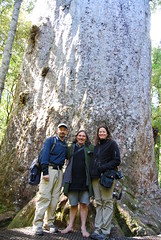September 18, 2012
 A large part of our studies in New Zealand is looking at the Maori culture and their relationship with the Pakeha (non-Maori people). We recently were able to listen to Malcolm Patterson, a political activist for the Marae that he was a part of, where he was the culture and heritage officer. The hill that the Marae was located on was the place where a major protest of the Treaty of Waitangi occurred. Patterson told us about life on the Marae and his history. One thing that I noticed about his talk was how much he valued his ancestry and their land. He told us that when he was a young boy, his grandfather took him out to the hill and told him that this was his land and that he needed to take care of it. They just have a very deep connection to their home and their ancestors. Later in the week, we had the opportunity to visit the Treaty house in Waitangi. This area was where the controversial Treaty of Waitangi was written in 1840. There we were able to go into a Maori meeting house that was built to show the Maori participation in the makings of the Treaty. It was a beautiful building with carvings all around the inside of it, representing the different characteristics and ancestors from every tribe. To continue our Maori studies, we were able to talk to Sam Chapman, who is a respected figure in restorative justice issues. His work and calling revolves around working through members of the Mongrel gang, one responsible for a majority of violence in Auckland. He takes members into his house and works with them and transforms them. He told us that many of the gang members have been rejected from their Maraes and their families, and that the gang life is all they know. Sam has and hopes to continue to provide an alternative to the negative influences. He focuses on reconciliation and restoring their way of life. Sam, Malcolm, and the Treaty House have shown us just parts of this amazing culture, and I can’t wait to see more.
A large part of our studies in New Zealand is looking at the Maori culture and their relationship with the Pakeha (non-Maori people). We recently were able to listen to Malcolm Patterson, a political activist for the Marae that he was a part of, where he was the culture and heritage officer. The hill that the Marae was located on was the place where a major protest of the Treaty of Waitangi occurred. Patterson told us about life on the Marae and his history. One thing that I noticed about his talk was how much he valued his ancestry and their land. He told us that when he was a young boy, his grandfather took him out to the hill and told him that this was his land and that he needed to take care of it. They just have a very deep connection to their home and their ancestors. Later in the week, we had the opportunity to visit the Treaty house in Waitangi. This area was where the controversial Treaty of Waitangi was written in 1840. There we were able to go into a Maori meeting house that was built to show the Maori participation in the makings of the Treaty. It was a beautiful building with carvings all around the inside of it, representing the different characteristics and ancestors from every tribe. To continue our Maori studies, we were able to talk to Sam Chapman, who is a respected figure in restorative justice issues. His work and calling revolves around working through members of the Mongrel gang, one responsible for a majority of violence in Auckland. He takes members into his house and works with them and transforms them. He told us that many of the gang members have been rejected from their Maraes and their families, and that the gang life is all they know. Sam has and hopes to continue to provide an alternative to the negative influences. He focuses on reconciliation and restoring their way of life. Sam, Malcolm, and the Treaty House have shown us just parts of this amazing culture, and I can’t wait to see more.
-Patrice Hostetter
September 13, 2012
What a beautiful morning! I say that a lot here, but how could you not? I’m writing beside a stream just down from camp. It is still a native stream, so no trout – still beautiful though. I’ve seen some birds; one was a tui, not sure about the others.
Yesterday was a cool day. We got a break from museums and lectures and were able to explore the kauri forest. First, we went to the Waipoua Forest where Stephen King, a well-known  conservationist, let us walk around. He showed us some of the native plants and trees and explained just how complex their life cycle is. We then traveled to a kauri forest where some of the largest kauri trees are located. One of them had a circumference of nearly 50 feet! Stephen King explained that some of the mammoth trees were 2000 years old. It’s crazy to think that the tree I was looking at was alive while Christ was walking the earth. I can only imagine what else these trees have seen in history.
conservationist, let us walk around. He showed us some of the native plants and trees and explained just how complex their life cycle is. We then traveled to a kauri forest where some of the largest kauri trees are located. One of them had a circumference of nearly 50 feet! Stephen King explained that some of the mammoth trees were 2000 years old. It’s crazy to think that the tree I was looking at was alive while Christ was walking the earth. I can only imagine what else these trees have seen in history.
After the kauri forest, we went to a tree farm that Stephen King maintained. While there, we weeded baby kauri trees and helped him out with anything else he needed. To reward us for our help we went up to a hill and planted a small kauri tree. The tree was seven years old and has another 993 years to go before it will reach maturity. We will never be able to see it grow high and mighty while we are on this earth, but someday we will be able to look down and see a full grown kauri tree planted by students from EMU.
-Aaron Spicher